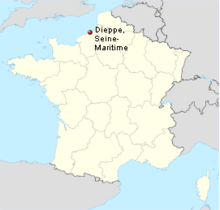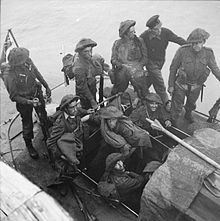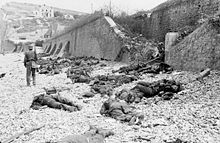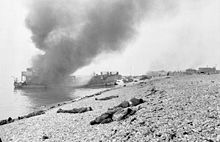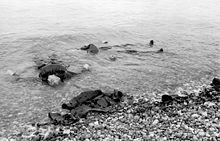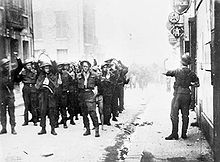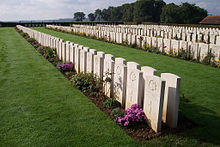- Dieppe Raid
-
For other uses, see Dieppe (disambiguation).
Dieppe Raid Part of the North West Europe Campaign 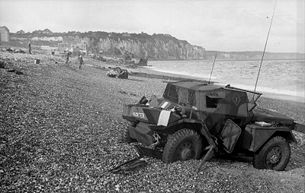
Dieppe's chert beach and cliff immediately following the raid on 19 August 1942. A Dingo Scout Car has been abandoned.Date 19 August 1942 Location Dieppe, France Result German victory Belligerents  Canada
Canada
 United Kingdom
United Kingdom
 Free Polish Forces
Free Polish Forces Germany
GermanyCommanders and leaders  Louis Mountbatten
Louis Mountbatten
 J. H. Roberts
J. H. Roberts
 Trafford Leigh-Mallory
Trafford Leigh-Mallory Gerd von Rundstedt
Gerd von Rundstedt
 Konrad Haase
Konrad HaaseStrength Infantry  Canada
Canada
2nd Canadian Infantry Division United Kingdom
United Kingdom
No. 3 Commando
No. 4 Commando*
* inc. 50 US Rangers
No. 10 (Inter-Allied) Commando (part)Royal Navy
237 ships and landing barges including eight destroyersRoyal Air Force
74 Squadrons
~10,500 men
302nd Static Infantry Division
~1,500 men
Does not include Luftwaffe and KriegsmarineCasualties and losses Ground forces
Canada
3,367 dead, wounded or captured
United Kingdom:
275 commandos
United States
3 dead
Royal Navy
One destroyer
33 landing craft
550 dead and wounded
Royal Air Force
64 Supermarine Spitfires
20 Hawker Hurricanes
6 Boston bombers
10 Mustang Mk 1
62 killed, 30 wounded, 17 capturedGround forces
311 dead,
280 wounded
Luftwaffe
23 Fw 190
25 Dornier Do 217Prelude
1939
Phoney War – Saar – The Heligoland Bight
1940
Luxembourg – The Netherlands – (The Hague – Rotterdam – Zeeland – Rotterdam Blitz) – Belgium – (Fort Eben-Emael – Hannut – Gembloux ) – France – (Sedan – Arras – Lille – Calais – Paula – Dunkirk – Dunkirk evacuation – Italian Invasion of France) – Britain - (Adlertag - The Hardest Day - Battle of Britain Day - The Blitz) – Sea Lion
1942–1943
Cerberus and Donnerkeil – St Nazaire Raid – Dieppe Raid
1944–1945
Overlord – Dragoon – Siegfried Line – Market Garden – (Arnhem) – Hürtgen Forest – Aachen – Queen - Scheldt – Bulge – (Nordwind – Bodenplatte) – Colmar Pocket – Invasion of Germany
Strategic Campaigns
The Blitz – Defence of the Reich – Battle of AtlanticThe Dieppe Raid, also known as the Battle of Dieppe, Operation Rutter or later on Operation Jubilee, during the Second World War, was an Allied attack on the German-occupied port of Dieppe on the northern coast of France on 19 August 1942. The assault began at 5:00 AM and by 10:50 AM the Allied commanders had been forced to call a retreat. Over 6,000 infantrymen, predominantly Canadian, were supported by limited Royal Navy and large Royal Air Force contingents. The objective is unclear, and has largely been explained as serving the personal ambitions of Vice-Admiral Louis, Lord Mountbatten, then Chief of Combined Operations acting without specific authorisation, and therefore without access to the necessary resources and intelligence.[1][page needed] Possible objectives included seizing and holding a major port for a short period, both to prove it was possible and to gather intelligence from prisoners and captured materials while assessing the German responses. The Allies also wanted to destroy coastal defences, port structures and all strategic buildings. The raid could have given a morale boost to the troops, resistance and general public, while assuring the Soviet Union of the commitment of the United Kingdom and the United States.
No major objectives of the raid were accomplished. A total of 3,623 of the 6,086 men (almost 60%) who made it ashore were either killed, wounded, or captured. The air force failed to lure the Luftwaffe into open battle, losing 96 aircraft (at least 32 to flak or accidents)[2] compared to 48 lost by the Luftwaffe, while the Royal Navy lost 33 landing craft and one destroyer. The events at Dieppe later influenced preparations for the North African (Operation Torch) and Normandy landings (Operation Overlord).
Contents
Background
In the immediate aftermath of the evacuation of the British Expeditionary Forces from Dunkirk, the British started on the development of a substantial raiding force under the umbrella of Combined Operations. This was accompanied by development of techniques and equipment for amphibious warfare. In late 1941 a scheme was put forward for the landing of 12 divisions around Le Havre based on a withdrawal of German troops to counter Soviet success in the east. From this came a proposed test of the scheme in the form of Operation Rutter. Rutter was to test the feasibility of capturing a port in the face of opposition, the investigation of the problems of operating the invasion fleet, and testing equipment and techniques of the assault.[3]
Dieppe, a coastal town in the Seine-Maritime department of France, is built along a long cliff that overlooks the English Channel. The River Scie is on the western end of the town and the River Arques flows through the town and into a medium-sized harbour. In 1942, the Germans had demolished some seafront buildings to aid in coastal defence and had set up two large artillery batteries at Berneval and Varengeville. One important consideration for the planners was that Dieppe was within range of the Royal Air Force's fighter aircraft.[4]
There was also incredible pressure from the Soviet government to open up a second front in Western Europe. By 1942, Operation Barbarossa had failed, however the Germans were deep into Soviet territory. Joseph Stalin himself demanded that the Allies create a second front in France to force the Germans to move at least 40 divisions away from the Eastern Front to remove some of pressure on the Red Army.[5]
Plan
Further information: Operation Jubilee order of battleThe Dieppe raid was a major operation planned by Vice-Admiral Lord Mountbatten of Combined Operations Headquarters. The attacking force would consist of around 5,000 Canadians, 1,000 British troops, and 50 United States Rangers. The Royal Navy would supply 237 ships and landing craft, and the Royal Air Force 74 squadrons of aircraft, of which 66 were fighter squadrons.[6]
Originally conceived in April 1942 by Combined Operations Headquarters and code named "Operation Rutter", the Allies planned to conduct a major division-sized raid on a German-held port on the French Channel coast and to hold it for the duration of at least two tides. They would effect the greatest amount of destruction of enemy facilities and defences before withdrawing. This original plan was approved by the chiefs of staff in May 1942. It included British parachute units attacking German artillery batteries on the headlands on either side of the Canadians who would carry out a frontal assault from the sea.[7] The parachute operation was later cancelled and instead No. 3 Commando and No. 4 Commando would land by sea and attack the artillery batteries.[6] In June, the BBC started broadcasting warnings to French civilians of a "likely" war, urging them to quickly evacuate the Atlantic coastal districts of occupied France.[8][9]
The troops were drawn from Combined Operations and South-Eastern Command, under Lieutenant General Bernard Law Montgomery. The plan called for an unimaginative frontal assault, without any heavy preliminary air bombardment. Under pressure from the Canadian government to ensure that Canadian troops saw some action, the 2nd Canadian Infantry Division, commanded by Major General John Hamilton Roberts, was selected for the main force.[6]
Armoured support was provided by the 14th Army Tank Regiment (The Calgary Regiment (Tank)) with 58 of the new Churchill tanks, to be delivered using the new landing craft tank (LCT).[10] The tanks had a mixture of armament with QF 2 pounder gun–armed tanks fitted with a close support howitzer in the hull operating alongside QF 6 pounder–armed tanks. In addition, three of the Churchills were equipped with flame thrower equipment and all had adaptations enabling them to operate in the shallow water near the beach.
Intelligence on the area was sparse: there were dug-in German gun positions on the cliffs, but these had not been detected or spotted by air reconnaissance photographers. The planners had assessed the beach gradient and its suitability for tanks only by scanning holiday snapshots, which led to an underestimation of the German strength and of the terrain.[6]
German forces
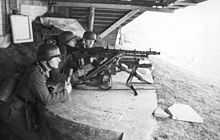 A German MG34 heavy machine gun emplacement
A German MG34 heavy machine gun emplacement
The German forces at Dieppe were on high alert having been warned by French double agents that the British were showing interest in the area. They had also detected increased radio traffic and landing craft being concentrated in the southern British coastal ports.[6]
Dieppe and the flanking cliffs were well defended, although the 1,500 strong garrison from the 302nd German Infantry Division comprised the 570th, 571st and 572nd Infantry Regiments, each of two battalions, the 302nd Artillery Regiment, the 302nd Reconnaissance Battalion, the 302nd Anti-tank Battalion, the 302nd Engineer Battalion and 302nd Signal Battalion. They were deployed along the beaches of Dieppe and the neighbouring towns, covering all the likely landing places. In respect to machine guns, mortars and artillery, the city and port was adequately protected with a concentration on the main approach, (particularly in the myriad of cliff caves), and with a reserve at the rear. The defenders were stationed not only in the towns themselves, but also between the towns in open areas and highlands that overlooked the beaches. The German defence focused on setting up extensive defensive perimeters throughout the area. Elements of the 571st Infantry Regiment defended the Dieppe radar station near Pourville and the artillery battery over the Scie river at Varengeville. To the west the 570th Infantry Regiment were deployed near the artillery battery at Berneval.
The Luftwaffe forces were Jagdgeschwader 2 (JG2) and Jagdgeschwader 26 (JG26), with 200 fighters, mostly the Fw 190 and about 100 bombers from Kampfgeschwader 2 (KG2), Kampfgeschwader 45 (KG45), and Kampfgeschwader 77 (KG77), mostly Dornier 217s.
Initial landings
The Dieppe landings would take place on four beaches codenamed from east to west Blue, Red, White and Green. The Royal Regiment of Canada would land on Blue beach. The main landings would take place on Red and White beaches by the Royal Hamilton Light Infantry, the Essex Scottish Regiment, Les Fusiliers Mont-Royal, A Commando Royal Marines and the 14th Army Tank Regiment (The Calgary Regiment (Tank)). The South Saskatchewan Regiment and the Queen's Own Cameron Highlanders of Canada would land on Green beach.[6]
The Allied fleet left the south coast of England on the night of 18 August, preceded by minesweepers which cleared paths through the English Channel for them. The fleet included eight destroyers, motor gun boats who escorted the landing craft and motor launches. The initial landings began at 04:50 on 19 August, with attacks on the two artillery batteries on the flanks of the main landing area. These included Varengeville by No. 4 Commando, Pourville by the South Saskatchewan Regiment and the Queen's Own Cameron Highlanders of Canada, Puys by the Royal Regiment of Canada, and Berneval by No. 3 Commando. On their way in the landing craft and escorts heading towards Puys and Berneval had run into a small German convoy and exchanged fire at 03:48.[6]
No. 3 Commando
The mission for Lieutenant Colonel John Durnford-Slater and No. 3 Commando was to conduct two landings 8 miles (13 km) east of Dieppe to silence the coastal battery near Berneval. The battery could fire upon the landing at Dieppe some 4 miles (6.4 km) to the west. The three 170 mm and four 105 mm guns of 2/770 Batterie had to be out of action by the time the main force approached the main beach.
The craft carrying No. 3 Commando, approaching the coast to the east were not warned of the approach of a German coastal convoy that had been located by British "Chain Home" radar stations at 21:30. German S-boats escorting a German tanker torpedoed some of the landing craft and disabled the escorting Steam Gun Boat 5. Subsequently, Motor Launch 346 and Landing Craft Flak 1 combined to drive off the German boats but the group was dispersed, with some losses, and the enemy's coastal defences were alerted. Only 18 commandos got ashore at the right place. They reached the perimeter of the battery via Berneval and engaged their target with small arms fire. Although unable to destroy the guns, their sniping for a time managed to distract the battery to such good effect that the gunners fired wildly and there were no known instance of this battery sinking any of the assault convoy ships off Dieppe. The commandos were eventually forced to withdraw in the face of superior enemy forces.[6][7]
No. 4 Commando
The mission for Lieutenant Colonel Lord Lovat and No. 4 Commando (including 50 United States Army Rangers) was to conduct two landings 6 miles (9.7 km) west of Dieppe to neutralize the coastal battery near Varengeville. Landing on the right flank in force they climbed the steep slope, and attacked and neutralized their target, the artillery battery of six 150 mm guns. This was the only success of Operation Jubilee.[6] The commando then withdrew at 07:30 as planned.[4] Most of No. 4 safely returned to England. This portion of the raid was considered a model for future commando raids. Lord Lovat was awarded the Distinguished Service Order for his part in the raid,[11] and Captain Patrick Porteous No. 4 Commando, was awarded the Victoria Cross.[12][13][14]
Blue beach
The naval engagement between the small German convoy and the craft carrying No. 3 Commando had alerted the German defenders at Blue beach.[4] The landing near Puys by the Royal Regiment of Canada plus three platoons from the Black Watch of Canada and an artillery detachment was tasked to neutralize machine gun and artillery batteries protecting the Dieppe beach.[4] They were delayed by 20 minutes and the smoke screens that should have hidden their assault had lifted. With the advantage of surprise and darkness lost, the Germans had manned their defensive positions in preparation for the landings.[4] The well-fortified German forces held the Canadian forces that did land on the beach. As soon as they reached the shore, the Canadians found themselves pinned against the seawall and unable to advance.[4] The Royal Regiment of Canada was annihilated. Of the 556 men in the regiment, 200 were killed and 264 captured.[4]
Green beach
On Green beach at the same time that No. 4 Commando had landed, the South Saskatchewan Regiment was headed towards Pourville. They beached at 04:52 without having been detected. The regiment managed to leave their landing craft before the Germans could open fire. Unfortunately on the way in some of the landing craft had drifted off course and most of the battalion found themselves west of the River Scie rather than east of it. Because they had been landed in the wrong place, the regiment, whose objective was the hills east of the village, had to enter Pourville to cross the river by the only bridge.[4] Before the Saskatchewans managed to reach the bridge the Germans had positioned machine guns and anti-tank guns there which stopped their advance. With the regiment's dead and wounded piling up on the bridge, Lieutenant-Colonel Charles Cecil Ingersoll Merritt, the commanding officer, stepped forward and shouted to his men: "Come on over—there's nothing to it!" The assault resumed but again failed to gain any ground. The South Saskatchewans and the Cameron Highlanders of Canada, who had landed beside them, were unable to reach their target.[4][6] While the Camerons did manage to penetrate further inland than any other troops that day, they were also soon forced back as German reinforcements rushed to the scene.[6] With time running out, both regiments suffered more losses as they withdrew; only 341 men were able to reach the landing craft and embark, and increasing pressure meant that the rest were left to surrender. For his part in the battle, Lieutenant Colonel Merritt was awarded the Victoria Cross.[12]
Pourville radar station
One of the objectives of the Dieppe Raid was to discover the importance and accuracy of a German radar station on the cliff-top to the east of the town of Pourville. To achieve this, RAF Flight Sergeant Jack Nissenthall, a radar specialist, was attached to the South Saskatchewan Regiment. He was to attempt to enter the radar station and learn its secrets, accompanied by a small unit of 11 men of the Saskatchewans as bodyguards. Nissenthall volunteered for the mission fully aware that, due to the highly sensitive nature of his knowledge of Allied radar technology, his Saskatchewan bodyguard unit were under orders to kill him if necessary to prevent him being captured. He also carried a cyanide pill as a last resort. Nissenthall and his bodyguards failed to enter the radar station due to strong defences, but Nissenthall was able to crawl up to the rear of the station under enemy fire and cut all telephone wires leading to it. This forced the crew inside to resort to radio transmissions to talk to their commanders, transmissions which were intercepted by listening posts on the south coast of England. The Allies were able to learn a great deal about the arrays of German radar stations along the channel coast thanks to this one simple act, which helped to convince Allied commanders of the importance of developing radar jamming technology. Of this small unit, only Nissenthall and one other returned safely to England.[15][16]
Main Canadian landings
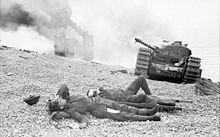 Canadian wounded and abandoned Churchill tanks after the raid. A landing craft is on fire in the background
Canadian wounded and abandoned Churchill tanks after the raid. A landing craft is on fire in the background
Preparing the ground for the main landings, four destroyers were bombarding the coast as landing craft approached. At 05:15 hours, they were joined by five RAF Hurricane squadrons who bombed the coastal defences and set a smoke screen to protect the assault troops. Between 05:20 and 05:23, thirty minutes after the initial landings the main frontal assault by the Essex Scottish and the Hamilton Light Infantry started. Their infantry were meant to be supported by Churchill tanks of the 14th Canadian Armoured Regiment landing at the same time but they arrived on the beach late. As a result the two infantry regiments had to attack without armour support. They were met with heavy machine gun fire from emplacements dug into the overlooking cliffs. Unable to clear the obstacles and scale the seawall, they suffered heavy losses.[4][6] When the tanks eventually arrived only 29 were landed. Two of those sank in deep water, and 12 more became bogged down in the soft shingle beach.[4] Only 15 of the tanks made it up to and across the seawall.[4] Once they crossed the seawall, they were confronted by a series of tank obstacles that prevented their entry into the town. Blocked from going further, they were forced to return to the beach where they provided fire support for the now retreating infantry. None of the tanks managed to return to England. All the crews that landed were either killed or captured.[4]
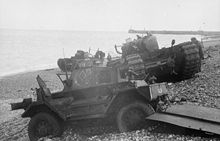 Daimler Dingo armoured car and two Churchill tanks bogged down on the shingle beach. The nearest Churchill tank has a flame thrower mounted in the hull, the rear tank has lost a track. Both have attachments to heighten their exhausts for wading through the surf.
Daimler Dingo armoured car and two Churchill tanks bogged down on the shingle beach. The nearest Churchill tank has a flame thrower mounted in the hull, the rear tank has lost a track. Both have attachments to heighten their exhausts for wading through the surf.
Unaware of the situation on the beaches because of a smoke screen laid by the supporting destroyers, Major General Roberts sent in the two reserve units: the Fusiliers Mont-Royal and the Royal Marines. At 07:00 the Fusiliers under the command of Lieutenant-Colonel Dollard Ménard in 26 landing craft sailed towards their beach. They were heavily engaged by the Germans, who hit them with heavy machine gun, mortar and grenade fire, and destroyed them; only a few men managed to reach the town.[4] Those men were then sent in towards the centre of Dieppe and became pinned down under the cliffs and Roberts ordered the Royal Marines to land in order to support them. Not being prepared to support the Fusiliers the Royal Marines had to transfer from their gunboats and motor boat transports onto landing craft. The Royal Marine landing craft were heavily engaged on their way in with many destroyed or disabled. Those Royal Marines that did reach the shore were either killed or captured. As he became aware of the situation the Royal Marine commanding officer Lieutenant Colonel Phillipps, stood up on the stern of his landing craft and signalled for the rest of his men to turn back. He was killed a few moments later.[6]
During the raid, a mortar platoon[17] from the Calgary Highlanders commanded by Lt. F. J. Reynolds was attached to the landing force, but stayed offshore after the tanks on board (code-named Bert and Bill) landed. Sergeants Lyster and Pittaway[18] were Mentioned in Despatches for their part in shooting down two German aircraft, and one officer of the regiment was killed while ashore with a brigade headquarters.[19]
At 11:00 under heavy fire, the withdrawal from the main landing beaches began and was completed by 14:00.[6]
Aftermath
Of the nearly 5,000 strong Canadian contingent deployed that early August morning, 3,367 were killed, wounded or taken prisoner; an exceptional casualty rate of 68%. [20] The British Commandos had lost 247 men. The Royal Navy lost one destroyer and 33 landing craft, suffering 550 dead and wounded. The RAF lost 106 aircraft to the Luftwaffe's 48. The German Army’s casualties totalled no more than 591.[6]
While the Canadian contingent fought bravely in the face of a determined enemy, it was ultimately circumstances outside their control which doomed their fate. [21] Despite criticism concerning the inexperience of the Canadian regiment that was engaged in battle, scholars have noted that even seasoned professionals would have been hard-pressed under the deplorable conditions suggested by their superiors. The commanding officers who designed the raid on Dieppe had not envisioned such losses.[21] This was, after all, one of the first attempts by the Allied faction on a German-held port city. As a consequence, planning from the highest ranks in preparation for the raid was minimal.[20] Critical strategic and tactical errors were made which resulted in scores of Allied (particularly Canadian) deaths. [20] However, these errors, and thus the Canadian losses that day, were not in vain. [20] The lessons learned at Dieppe essentially became the textbook of “what not to do” in future amphibious operations, and subsequently laid the framework for the Normandy landings just two years afterward. [22] Coincidentally, the lessons learned at Dieppe by the British, American and Canadian forces were also mirrored by the opposing German officials. Most notably, Dieppe highlighted:
- The need for preliminary artillery support;[21]
- The need for a sustained element of surprise;[21]
- The need for proper intelligence concerning enemy fortifications;[21]
- The avoidance of a direct frontal attack on a defended port city; and[21]
- The need for proper re-embarkation craft. [21]
However, certain measures were not implemented due more to foresight than to ignorance by the raid designers.[23] British and Canadian officials supposedly withheld the use of air and naval bombardments in an attempt to limit casualties of French civilians in the port-city core.[23] The planners of the Dieppe Raid feared that unjustifiable civilian losses would anger and further alienate the Vichy government; an unattractive option considering the intent of Operation Torch not three months later.[23]
The losses at Dieppe were claimed to be a necessary evil.[21] Mountbatten later justified the raid by arguing that lessons learned at Dieppe in 1942 were put to good use later in the war. He later claimed, “I have no doubt that the Battle of Normandy was won on the beaches of Dieppe. For every man who died in Dieppe, at least 10 more must have been spared in Normandy in 1944." In direct response to the raid on Dieppe, Winston Churchill remarked that, “My Impression of 'Jubilee' is that the results fully justified the heavy cost” and that it “was a Canadian contribution of the greatest significance to final victory.” [24]The amphibious assaults in North Africa followed three months after the Dieppe Raid and the more successful Normandy landings took place two years later.
As a testament to Canadian courage, three Victoria Crosses were awarded for the operation: to Captain Porteous, No. 4 Commando; the Reverend John Weir Foote, padre to Royal Hamilton Light Infantry; and Lieutenant Colonel Merritt of the South Saskatchewan Regiment. Both Foote and Merritt became prisoners of war. The 2nd Canadian Infantry Division would eventually liberate Dieppe in 1944, Major General Roberts, their commander, had by then been transferred to command reinforcement units in Britain.
As a consequence of the lessons learned at Dieppe, the British developed a whole range of specialist armoured vehicles which allowed their engineers to perform many of their tasks protected by armour, most famously Hobart's Funnies.[6] The disaster also identified a need for much heavier naval fire power in future raids and it was recognised that this should include aerial bombardment.[6] The operation showed major deficiencies in RAF ground support techniques, and this led to the creation of a fully integrated Tactical Air Force to support major ground offensives.[25]
German propaganda
Dieppe was in many ways a victory for German propaganda.[23]The Third Reich largely described the Dieppe raid as a military joke, noting the amount of time needed to design such an attack, combined with the incredible losses suffered by the Allies, points only to incompetence.[23] Joseph Goebbels and the Nazis manipulated newspapers and newsreels in order to produce propaganda regarding Dieppe as a major German victory.[23] These attempts were made to rally the public opinion of the German people despite serious internal issues as well as a great many casualties lost daily on the Eastern Front.[23]
The air battle
The Allied air operations supporting Operation Jubilee resulted in some of the fiercest air battles since 1940. The RAF's main objectives were to throw a protective umbrella over the amphibious force and beach heads and also to force the Luftwaffe forces into a battle of attrition on the Allies's own terms. Some 51 fighter squadrons of Spitfires were committed, with eight squadrons of Hurricane fighter-bombers, four squadrons of reconnaissance Mustang Mk Is and seven squadrons of No. 2 Group light bombers involved. Opposing these forces were some 120 operational fighters of Jagdgeschwadern 2 and 26 (JG 2 and JG 26), the Dornier Do 217s of Kampfgeschwader 2 and various anti-shipping bomber elements of III./KG 53, II./KG 40 and I./KG 77.
Although initially slow to respond to the raid, the German fighters soon made their presence felt over the port as the day wore on. While the Allied fighters were moderately successful in protecting the ground and sea forces from aerial bombing, the RAF came off second best versus the experienced and well-equipped Jagdgeschwaders.
While Fighter Command claimed to have inflicted heavy casualties on the Luftwaffe the ultimate balance sheet showed Allied aircraft losses amounted to 106, including 88 RAF fighters destroyed or damaged. Of this number, 44 Spitfires were lost in aerial combat and a further three were destroyed by Flak. A further 23 were destroyed or damaged by Flak, or in accidents. The overall figure for destroyed and damaged Spitfires is 70.[2] Around 18 bombers were also lost. Against this, 48 Luftwaffe aircraft were lost. Included in that total were 28 bombers, half of them Dornier Do 217s from KG2. One of the two Jagdgeschwadern, JG 2, lost 14 Fw 190s and eight pilots killed. JG26 lost six Fw 190s with their pilots.[26]
POW policies
Brigadier William Wallace Southam brought ashore his copy of the assault plan, classified as a secret document. Although he attempted to bury it under the pebbles at the time of his surrender, he was spotted and the plan retrieved by the Germans. The plan, later criticised for its size and needless complexity, contained orders to shackle prisoners.[citation needed] The Germans later also received reports of the bodies of German prisoners with their hands tied washing ashore after the Canadian withdrawal. When this was brought to Hitler's attention he ordered the shackling of Canadian prisoners, which led to a reciprocating order by British and Canadian authorities for German prisoners being held in Canada.[27] Though the Canadians were opposed to the plan, which they considered a danger to Canadian POWs in German hands, they reluctantly implemented it to maintain unity with the British. Nevertheless, as the Canadians expected, the shackling order led directly to trouble and the only known uprising at a Canadian prisoner of war camp during World War II, the so-called "Battle of Bowmanville". Subsequent to this event, the Canadian and German orders both eventually lost momentum in POW camps and were eventually abandoned after intercession by the Swiss.
The Germans decided to reward the town for not helping in the raid by freeing POWs from Dieppe in their custody, and did not bother to verify the long list given to them by the city officials. Thus hundreds of French prisoners were allowed to go free after the raid, many of whom had never even been to Dieppe. In addition, Hitler gave the town a gift of 10 million francs.[citation needed]
Debate over German foreknowledge
First-hand accounts and memoirs of many Canadian veterans who documented their experiences on the shores of Dieppe remark about the preparedness of the German defences as if they knew of the raid ahead of time. Commanding officer Lt. Colonel Labatt testified to having seen markers used for mortar practice, which appeared to have recently been placed, on the beach.[28] Furthermore, upon touching down on the Dieppe shore, the landing ships were immediately shelled with the utmost precision as troops began exiting. The recent target practice and subsequent precision shelling is indicative of a well-prepared army. In another instance, Major C. E. Page, while interrogating a German soldier, found out that four machine gun battalions were brought in "specifically" in anticipation of a raid. However, the most compelling information supporting German foreknowledge resides with the numerous accounts of interrogated German prisoners, German captors, and French citizens who all conveyed to Canadians that the Germans had been preparing for the anticipated Allied landings for weeks.[29][30]
Daily Telegraph crossword
On 17 August 1942, the clue "French port (6)" appeared in the Daily Telegraph crossword (compiled by Leonard Dawe), followed by the solution "Dieppe" the next day; on 19 August, the raid on Dieppe took place.[31] The War Office suspected that the crossword had been used to pass intelligence to the enemy and called upon Lord Tweedsmuir, then a senior intelligence officer attached to the Canadian Army, to investigate the crossword. Tweedsmuir, the son of John Buchan the author, later commented:
"We noticed that the crossword contained the word "Dieppe", and there was an immediate and exhaustive inquiry which also involved MI5. But in the end it was concluded that it was just a remarkable coincidence—a complete fluke".[32]
Dieppe War Cemetery
The soldiers who were killed during the Dieppe raid were buried by the Germans, creating a unique layout in the Dieppe Canadian War Cemetery—the headstones have been placed back-to-back in double rows, the norm for a German war cemetery, but unlike any other Commonwealth War Graves Commission site. When the Allies liberated Dieppe as part of Operation Fusilade in 1944, the grave markers were replaced but the layout was left unchanged to avoid disturbing the remains.
References
- Notes
- ^ Hughes-Wilson 2004
- ^ a b Franks 1998, pp. 56–62.
- ^ Buckingham 2004, p. 15.
- ^ a b c d e f g h i j k l m n "Dieppe raid." Canada in World War II, 7 June 2010.
- ^ Whitaker 1992, p. 29.
- ^ a b c d e f g h i j k l m n o p q Thompson, Julian. "The Dieppe Raid." BBC (World Wars in Depth series), 6 June 2010.
- ^ a b "OperationJubilee." Combined Operations, 7 June 2010.
- ^ "Warning by Radio: Notice of 'Likely' War Moves Given Civilians in Nazi-Held Zone." The New York Times, 9 June 1942. Retrieved: 9 September 2010.
- ^ Beattie, Edward W. "Big Commando Attack Due, England Hints". Pittsburgh Press, 8 June 1942. Retrieved: 9 September 2010.
- ^ Henry 1993, p. 6.
- ^ London Gazette: (Supplement) no. 35729. p. 4328. 2 October 1942. Retrieved 10 January 2008.
- ^ a b London Gazette: (Supplement) no. 35729. pp. 4323–4324. 2 October 1942. Retrieved 17 April 2008.
- ^ London Gazette: (Supplement) no. 35730. p. 4339. 2 October 1942. Retrieved 17 April 2008.
- ^ Dunning 2003, pp. 65–87.
- ^ Goldstein, Ron. "Jack Nissenthall: The VC Hero Who Never Was (Part 1a)." BBC (WW2 People's Story series), 2004. Retrieved: 30 April 2009.
- ^ Leasor, James. Green Beach. London: 2011. ISBN 978-1-908291-10-3
- ^ "Mortar platoon." calgaryhighlanders.com. Retrieved: 8 April 2010.
- ^ "Lyster and Pittaway." Harry Palmer Gallery. Retrieved: 8 April 2010.
- ^ Casualty Details—Insinger, Theodor Marie, Commonwealth War Graves Commission.
- ^ a b c d Robertson 1962, p. 386.
- ^ a b c d e f g h Maguire 1963, p. 190.
- ^ ...
- ^ a b c d e f g Hall, David. "The German View of the Dieppe Raid." Military History Lecture. Laurier Centre for Military Strategic and Disarmament Studies, Wilfrid Laurier University, Waterloo, 13 October 2011.
- ^ Maguire 1963, p. 181.
- ^ "RAF timeline 1942." Ministry of Defence (United Kingdom), 7 June 2010 via raf.mod.uk. Retrieved: 11 September 2010.
- ^ Weal 1996, p. 26.
- ^ Vance, Jonathan F. "Men in Manacles: The Shackling of Prisoners of War, 1942–1943." The Journal of Military History, Vol. 59, No. 3, July 1995, pp. 483–504.
- ^ Stacey 1944, paragraph 43.
- ^ Poolton and Poolton-Turney 1998, p. 46.
- ^ Whitaker 1992, p. XV.
- ^ "Mystery of the D-day crosswords, Part 1." [[Daily Record (Little Rock)|]]7 June 2010.
- ^ Gilbert 2008, pp. 19–20.
- Bibliography
- Alexander, Joseph H. Storm Landings: Epic Amphibious Battles in the Central Pacific. Annapolis, MD: Naval Institute Press, 2009. ISBN 978-1557500328.
- Buckingham, William. D-Day: The First 72 hours. Stroud, Gloucestershire, UK: Tempus Publishing. 2004. ISBN 0-75242-842-X.
- Churchill, Sir Winston. The Second World War. Cambridge, Massachusetts: The Riverside Press, 1953.
- Dunning, James. The Fighting Fourth. Stroud, Gloucestershire, UK: Sutton Publishing, 2003. ISBN 0-7509-3095-0.
- Franks, Norman L. R. Royal Air Force Losses of the Second World War. Volume 2. Operational Losses: Aircraft and crews 1942–1943. London: Midland Publishing Limited, 1998. ISBN 1-85780-075-3.
- Gilbert, Val. A Display of Lights (9): The Lives and Puzzles of the Telegraph's Six Greatest Cryptic Crossword Setters. London: Macmillan (Telegraph Group Limited), 2008. ISBN 978-0230714465.
- Henry, Hugh G. "Dieppe Through the Lens of the German War photographer." London: After the Battle, 1993. ISBN 0-900-91376-2. A Canadian historian covers the actions of each one of the 29 tanks disembarked on the raid with photos, oral history and primary sources. The author later did his doctoral dissertation on the raid.
- Hughes-Wilson, John. Military Intelligence Blunders and Cover-ups. Bath, Avon, UK: Robinson Publishing Ltd. 2004. ISBN 978-1841198712.
- Leasor, James. Green Beach. London: 2011. ISBN 978-1-908291-10-3.
- Maguire, Eric. "Evaluation." Dieppe, August 19. London: J. Cape, 1963.
- Poolton, Jack with Jayne Poolton-Turney. Destined to Survive: A Dieppe Veteran's Story. Toronto: Dundurn Press 1998. ISBN 1-55002-311-X.
- Robertson, Terence. Dieppe: The Shame and the Glory. Boston: Little, Brown, 1st U.S. edition, 1962.
- Stacey, Colonel C.P. "The Lessons of Dieppe". Report No. 128: The Lessons of Dieppe and their Influence on the Operation Overlord. Ottawa, Canada: Department of National Defence Canadian Forces, 1944.
- Taylor, A.J.P. The Second World War: An Illustrated History. London: Penguin Books, 1976. ISBN 0-14004-135-4.
- Villa, Brian Lorring. Unauthorized Action: Mountbatten and the Dieppe Raid. Oxford, UK: Oxford University Press, 1991. ISBN 0-19540-679-6.
- Weal, John. Focke-Wulf Fw 190 Aces of the Western Front. London: Osprey, 1996. ISBN 978-1-85532-595-1.
- Whitaker, Denis and Shelagh. Dieppe: Tragedy to Triumph. Whitby, Ontario: McGraw-Hill Ryerson, 1993. ISBN 0-07-551641-1.
External links
- London Gazette: (Supplement) no. 38045. pp. 3823–3828. 12 August 1947. Retrieved 10 January 2008. Operation Jubilee Official despatch and narrative submitted by Naval Force Commander Captain John Hughes-Hallett on 30 August 1942.
- WWII: The Dieppe Raid - Canada at War—Photos, video, information and more
- The Dieppe Raid—Juno Beach Centre
- Raid on Dieppe
- The Contentious Legacy of Dieppe—CBC Digital Archives
- The Dieppe Raid
 British Commando raids of the Second World War
British Commando raids of the Second World WarA Abstention · Agreement · Ambassador · Anklet · Archery · Aquatint · Aflame · Anglo · Amherst · Archway · Abercrombie · Acid Drop · Albumen · AstrakanB C D E ExporterF G H Hardtack · Huckaback · Hawthorn · Houndsworth
I J K L M N P R Rimau · Roast · Roundabout · Rumford
S T British Commandos · List of Commando raids on the Atlantic wallWorld War II Participants Timeline - Burma
- Changsha (1942)
- Coral Sea
- Gazala
- Midway
- Blue
- Stalingrad
- Dieppe
- El Alamein
- Torch
- Guadalcanal
Aspects GeneralWar crimes- German and Wehrmacht war crimes
- The Holocaust
- Italian war crimes
- Japanese war crimes
- Unit 731
- Allied war crimes
- Soviet war crimes
- United States war crimes
- German military brothels
- Camp brothels
- Rape during the occupation of Japan
- Comfort women
- Rape of Nanking
- Rape during the occupation of Germany
- Nazi crimes against Soviet POWs
- Italian prisoners of war in the Soviet Union
- Japanese prisoners of war in the Soviet Union
- Japanese prisoners of war in World War II
- German prisoners of war in the Soviet Union
- Finnish prisoners of war in the Soviet Union
- Polish prisoners of war in the Soviet Union
- Romanian prisoners of war in the Soviet Union
- German prisoners of war in the United States
Categories:- 1942 in France
- Battles and operations of World War II involving Poland
- Battles of World War II involving Canada
- Battles of World War II involving Germany
- Battles of World War II involving the United Kingdom
- Battles of World War II involving the United States
- Conflicts in 1942
- Military history of Canada during World War II
- World War II British Commando raids
- World War II operations and battles of the Western European Theatre
- World War II sites
Wikimedia Foundation. 2010.

